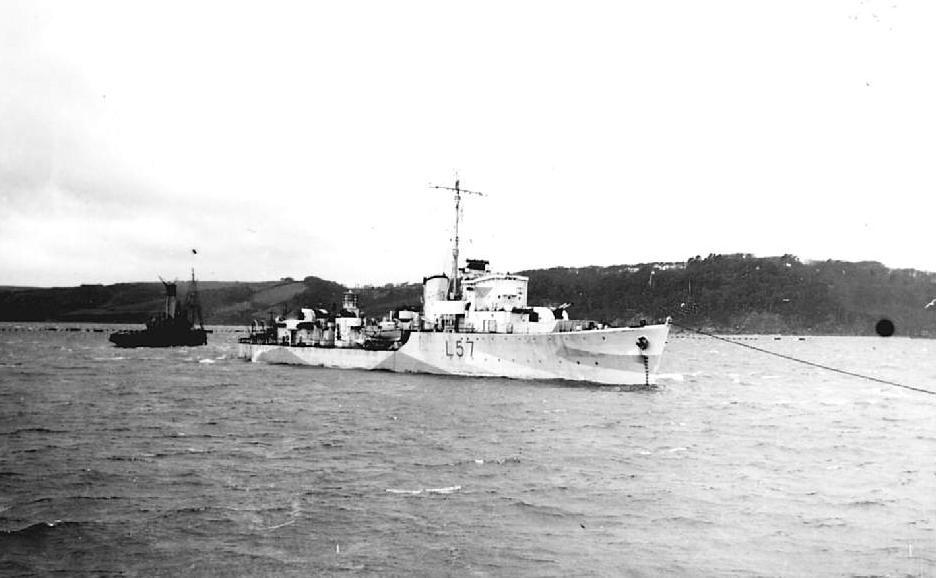HMS Limbourne (L57)
| The below content is licensed according to Creative Commons Attribution-ShareAlike License contrary to the public domain logo at the foot of the page. It originally appeared on http://en.wikipedia.org. The original article might still be accessible here. You may be able to find a list of the article's previous contributors on the talk page. |
HMS Limbourne (L57) was a Hunt class destroyer escort destroyer, operated by the Royal Navy.[1][2] She was sunk in action, off German occupied Guernsey, on October 23, 1943.
Design
Limbourne was one of seven Type III Hunt-class destroyers ordered for the Royal Navy on 4 July 1940, as part of the 1940 War Emergency Programme.[3] The Hunt class was meant to fill the Royal Navy's need for a large number of small destroyer-type vessels capable of both convoy escort and operations with the fleet. The Type III Hunts differed from the previous Type II ships in replacing a twin 4-inch gun mount by two torpedo tubes to improve their ability to operate as destroyers.[4][5]
The Type III Hunts were 264 ft long between perpendiculars and 280 ft overall, with a beam was 31 ft and draught Template:Convert/and/in. Displacement was 1050 long tons standard and 1490 long tons under full load. Two Admiralty boilers raising steam at 300 pounds per square inch and 620 degrees Fahrenheit fed Parsons single-reduction geared steam turbines that drove two propeller shafts, generating 19,000 ship horsepower at 380 rpm. This gave a design maximum speed of 27 knots.[6] 345 long tons of oil fuel were carried, giving a range of 3700 nautical miles at 15 knots.[7]
Main gun armament was four 4 inch (102 mm) QF Mk XVI dual purpose (anti-ship and anti-aircraft) guns in two twin mounts, with a quadruple 2-pounder "pom-pom" and three Oerlikon 20 mm cannon providing close-in anti-aircraft fire.[8][6] Two 21 inch torpedo tubes were fitted in a single twin mount, while two depth charge chutes, four depth charge throwers and 70 depth charges comprised the ship's anti-submarine armament. Type 291 and Type 285 radar was fitted, as was Type 128 sonar.[8][9]
Construction and service
Limbourne was laid down at Alexander Stephen and Sons' shipyard at Linthouse, Glasgow on 8 April 1941. She was launched on 12 May 1942, and was completed on 24 October 1942.[3]
After commissioning, Limbourne spent November in sea trials and work up with the Home Fleet at Scapa Flow, interrupting work up to escort the battleship HMS Howe (32) out to Gibraltar and the aircraft carrier HMS Victorious (R38) and battleship HMS Duke of York (17) back to the UK from the Mediterranean Sea following the Anglo-American landings in North Africa. After completing workup, she joined the 15th Destroyer Flotilla based at Devonport.[10][1]
January and February she was employed as an escort to convoys between the UK and Gibraltar.[1] During the rest of her operational life she helped patrol the Western Approaches and the Bay of Biscay.
On 23 October Limbourne was sailing with the light cruiser Template:HMS, when they were engaged by a large German Type 39 torpedo boat.[1][2] Both ships were hit by torpedoes. 40 crewmembers of Limbourne were killed. Attempts were made to tow her back to port, for repairs.[11] But tow attempts had to be abandoned, and she was scuttled.
In 2011 the BBC News reported that "The incident was used as an illustration of what not to do by the Royal Navy tactical school."[12] They reported that the Royal Navy ships were sunk by a smaller but better trained German force.
Notes
- ↑ 2.0 2.1 "HMS Charybdis and HMS Limbourne". The Royal Court of Guernsey. http://www.guernseyroyalcourt.gg/article/1940/HMS-Charybdis-and-HMS-Limbourne. Retrieved 2019-08-11. "HMS Charybdis and HMS Limbourne were sunk as a result of enemy action at sea on 23 October 1943 taking part in 'Operation Tunnel' off the north coast of Brittany near Les Sept Isles which lie south of the Channel islands."
- ↑ 3.0 3.1 English 1987, p. 17
- ↑ English 1987, pp. 7, 12
- ↑ Lenton 1970, pp. 83, 85
- ↑ 6.0 6.1 Lenton 1970, p. 97
- ↑ Whitley 2000, p. 147
- ↑ 8.0 8.1 Gardiner & Chesneau 1980, p. 46
- ↑ English 1987, pp. 12–13
- ↑ English 1987, p. 78
- ↑ "HMS Charybdis and HMS Limbourne sinking remembered". BBC News. 2014-09-14. https://www.bbc.com/news/world-europe-guernsey-29400164. Retrieved 2019-08-11. "An attempt to tow HMS Limbourne was unsuccessful and she was later sunk by torpedoes from HMS Talybont and gunfire from HMS Rocket."
- ↑ "HMS Limbourne survivor thanks Guernsey". BBC News. 2011-10-03. https://www.bbc.com/news/world-europe-guernsey-15151562. Retrieved 2019-08-11. "The disaster struck on Operation Tunnel when, due to errors made ashore and afloat, the British task force was outmanoeuvred by a smaller but better trained enemy force."
References
- Barnett, Corelli (2000). Engage The Enemy More Closely. London: Penguin. ISBN 0-141-39008-5.
- English, John (1987). The Hunts: A history of the design, development and careers of the 86 destroyers of this class built for the Royal and Allied Navies during World War II. World Ship Society. ISBN 0-905617-44-4.
- Friedman, Norman (2008). British Destroyers and Frigates: The Second World War and After. Barnsley, UK: Seaforth Publishing. ISBN 978-1-84832-015-4.
- Conway's All The World's Fighting Ships 1922–1946. London: Conway Maritime Press. 1980. ISBN 0-85177-146-7.
- Kemp, Paul (1999). The Admiralty Regrets: British Warship Losses of the 20th Century. Stroud, UK: Sutton Publishing. ISBN 0-7509-1567-6.
- Lenton, H.T. (1970). Navies of the Second World War: British Fleet & Escort Destroyers Volume Two. London: Macdonald & Co.. ISBN 0-356-03122-5.
- Rohwer, Jürgen; Hümmelchen, Gerhard (1992). Chronology of the War at Sea 1939–1945. London: Greenhill Books. ISBN 1-85367-117-7.
- Roskill, S. W. (1960). The War at Sea 1939–1945: Volume III: The Offensive: Part I: 1st June 1943–31st May 1945. History of the Second World War: United Kingdom Military Series. London: Her Majesty's Stationery Office.
- Whitley, M. J. (2000). Destroyers of World War Two: An International Encyclopedia. London: Cassell & Co. ISBN 1-85409-521-8.
